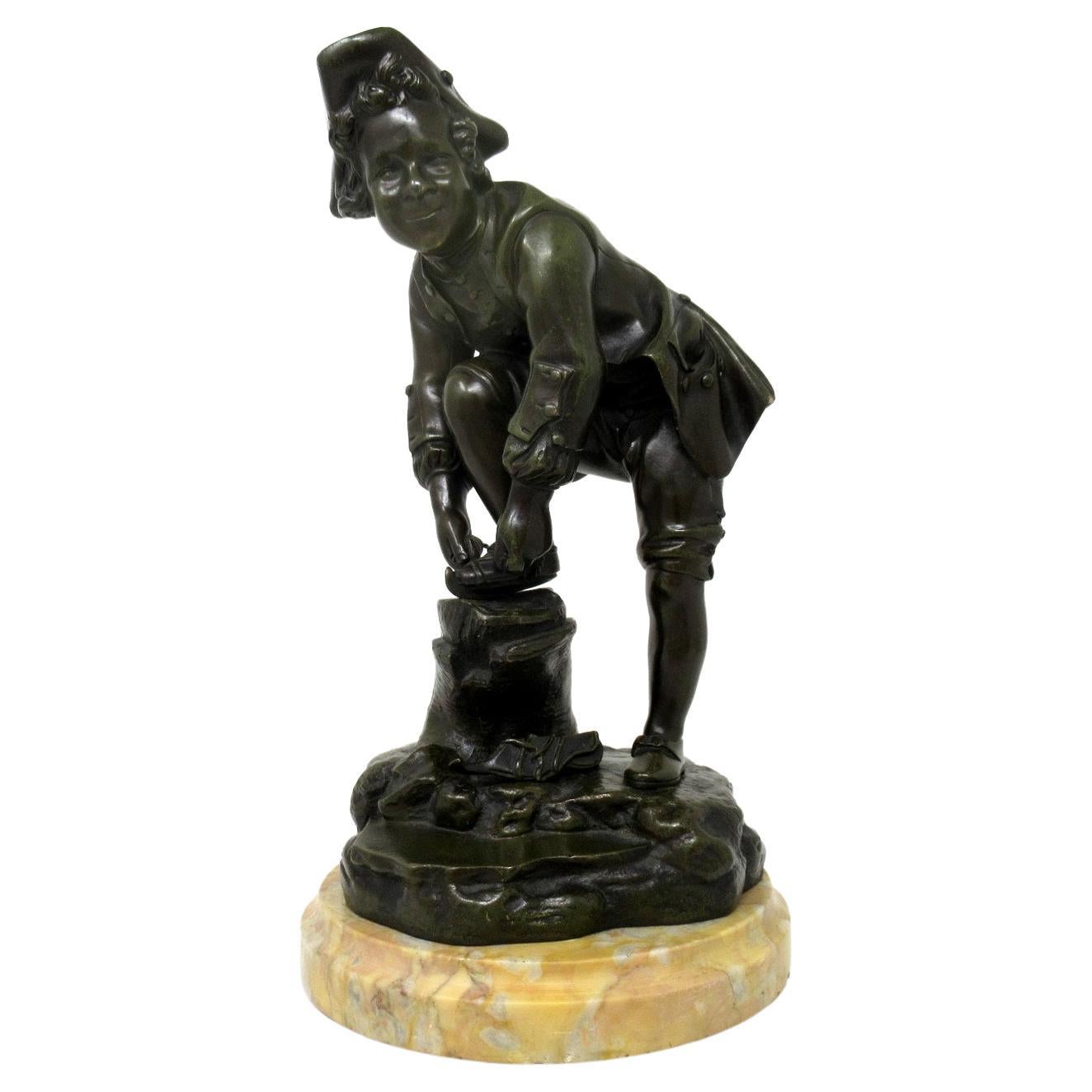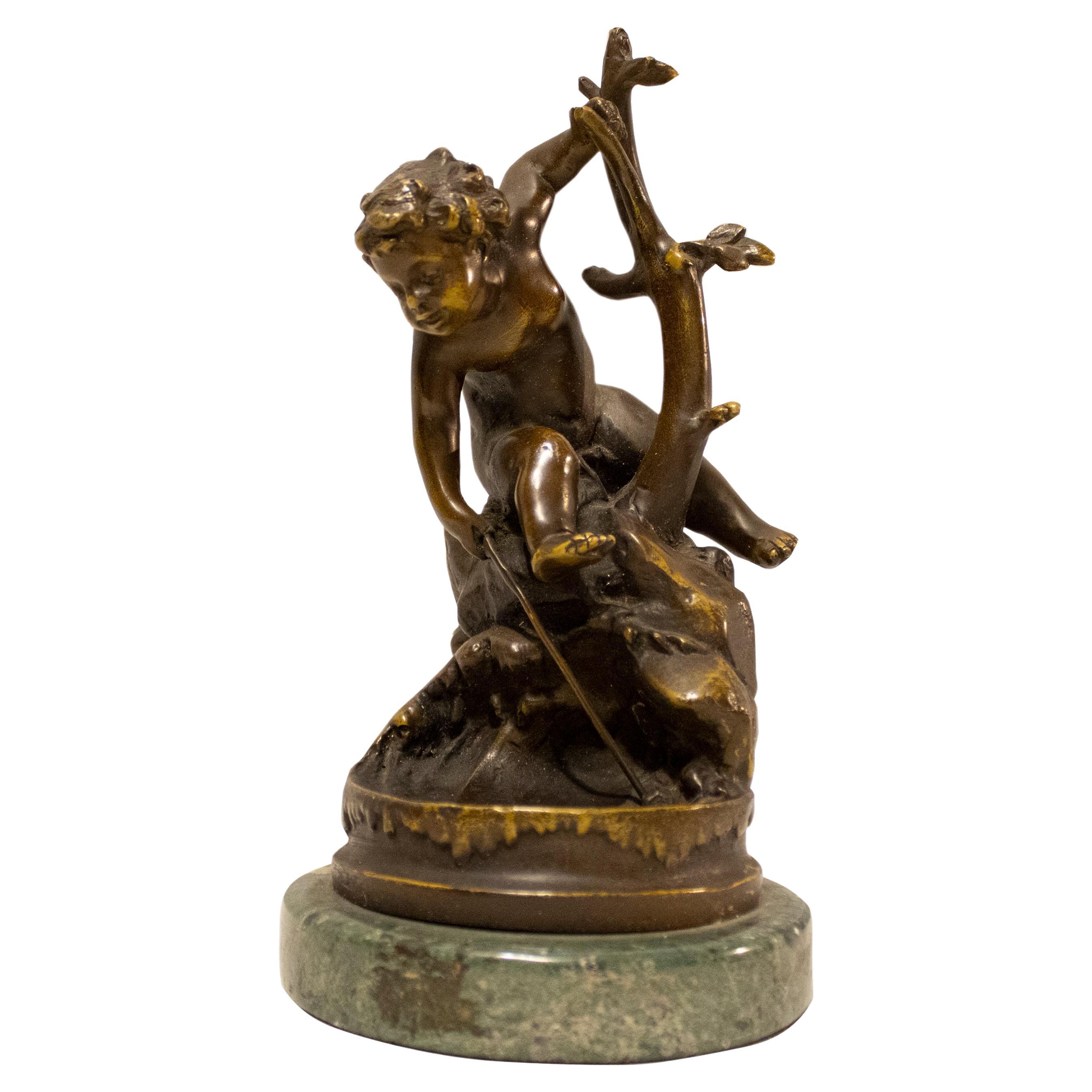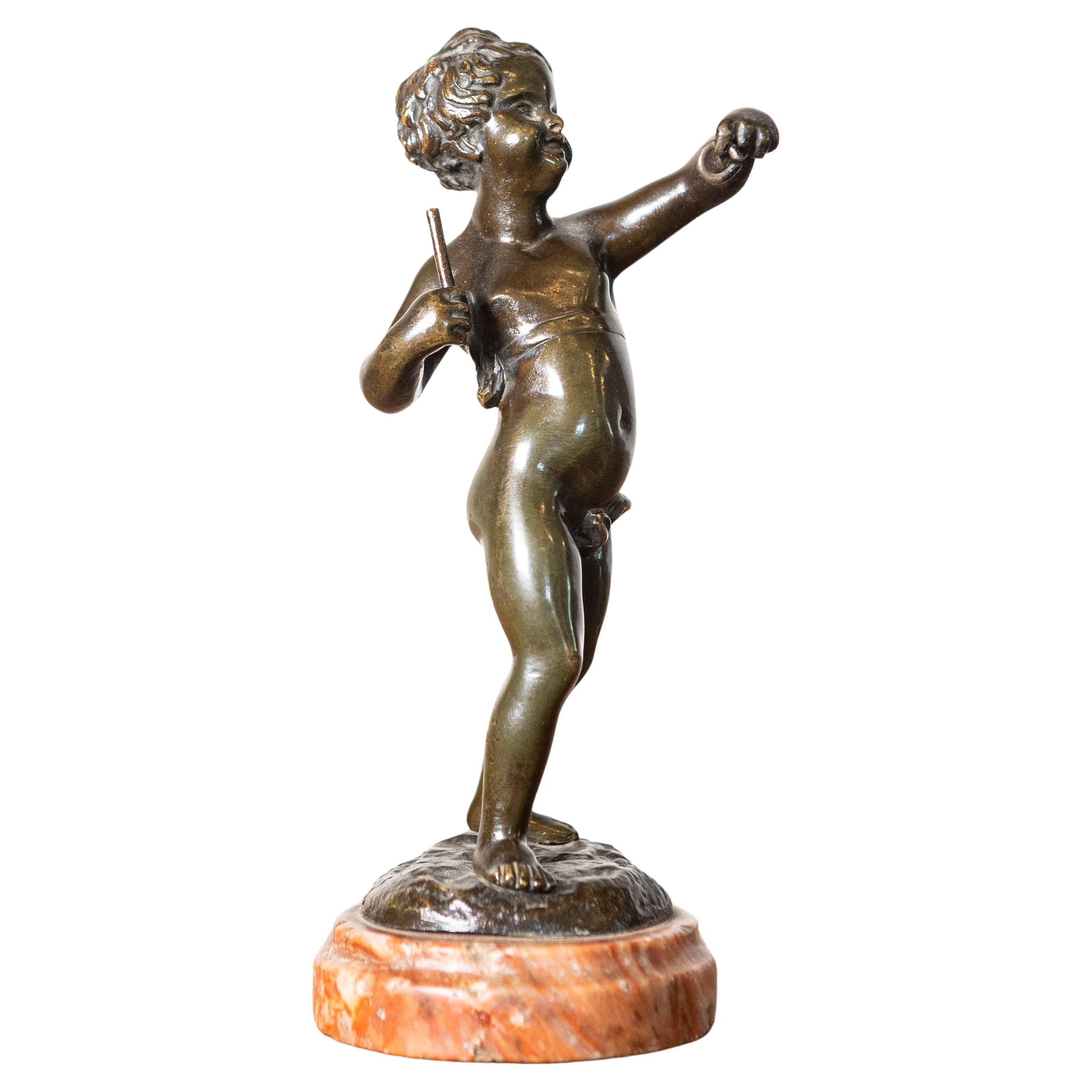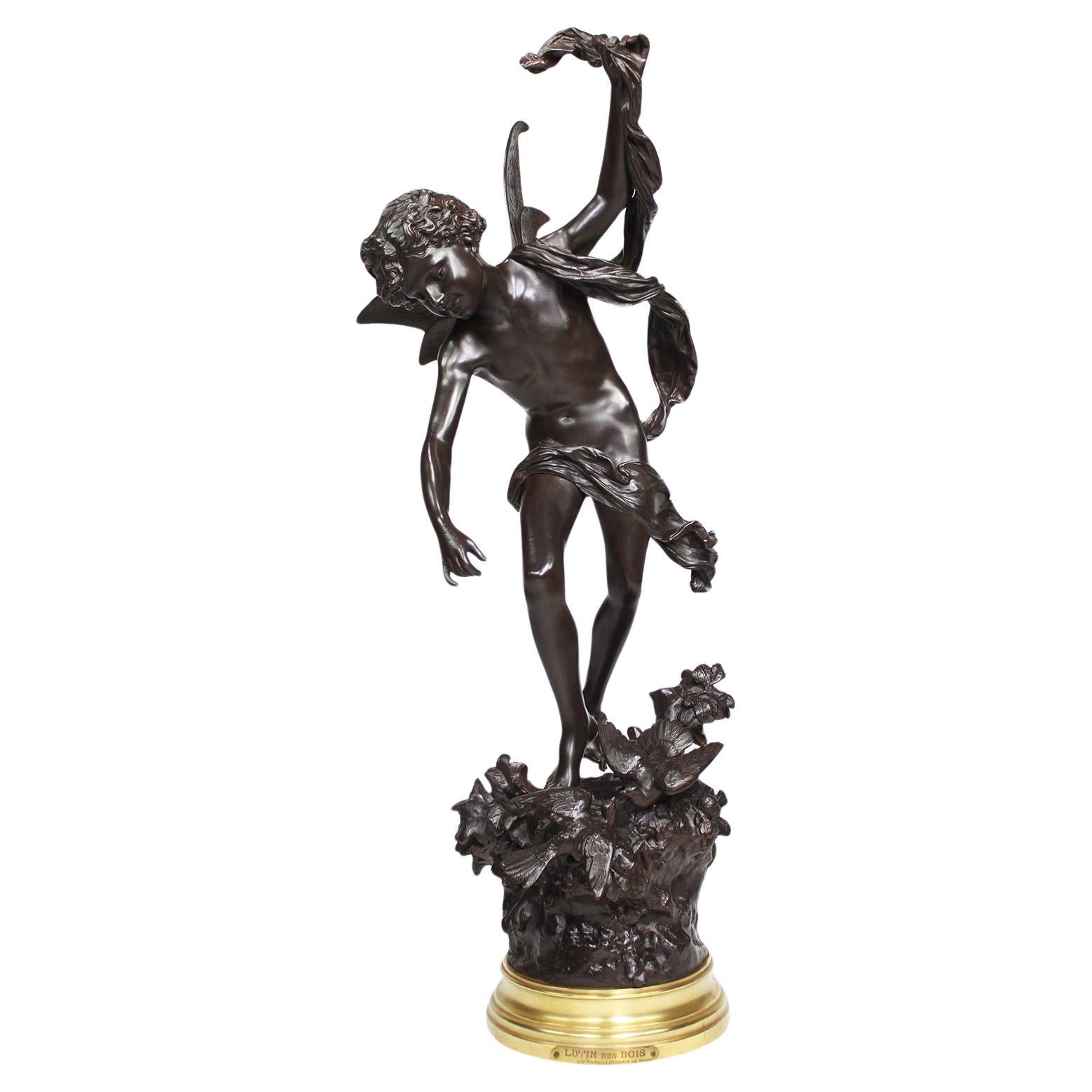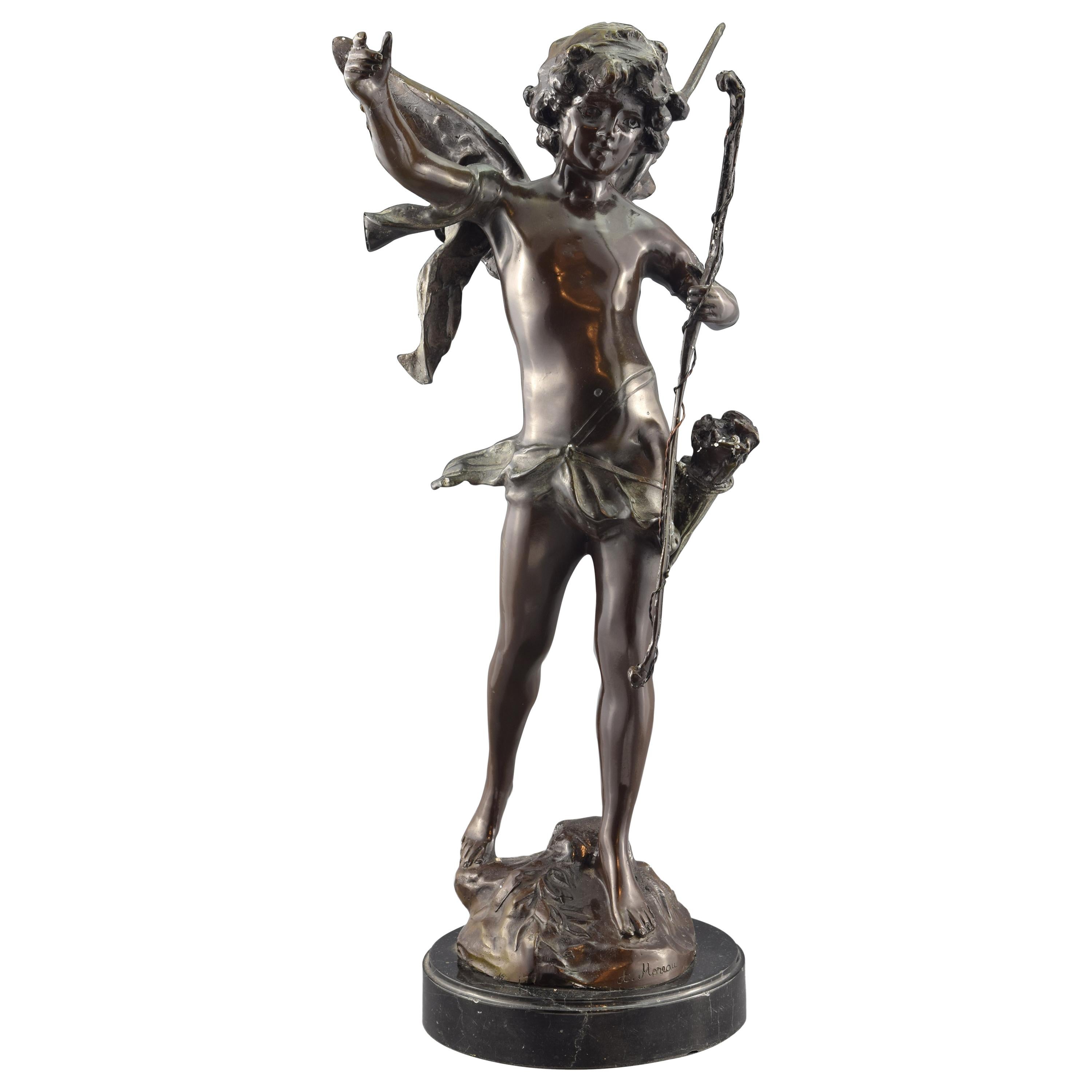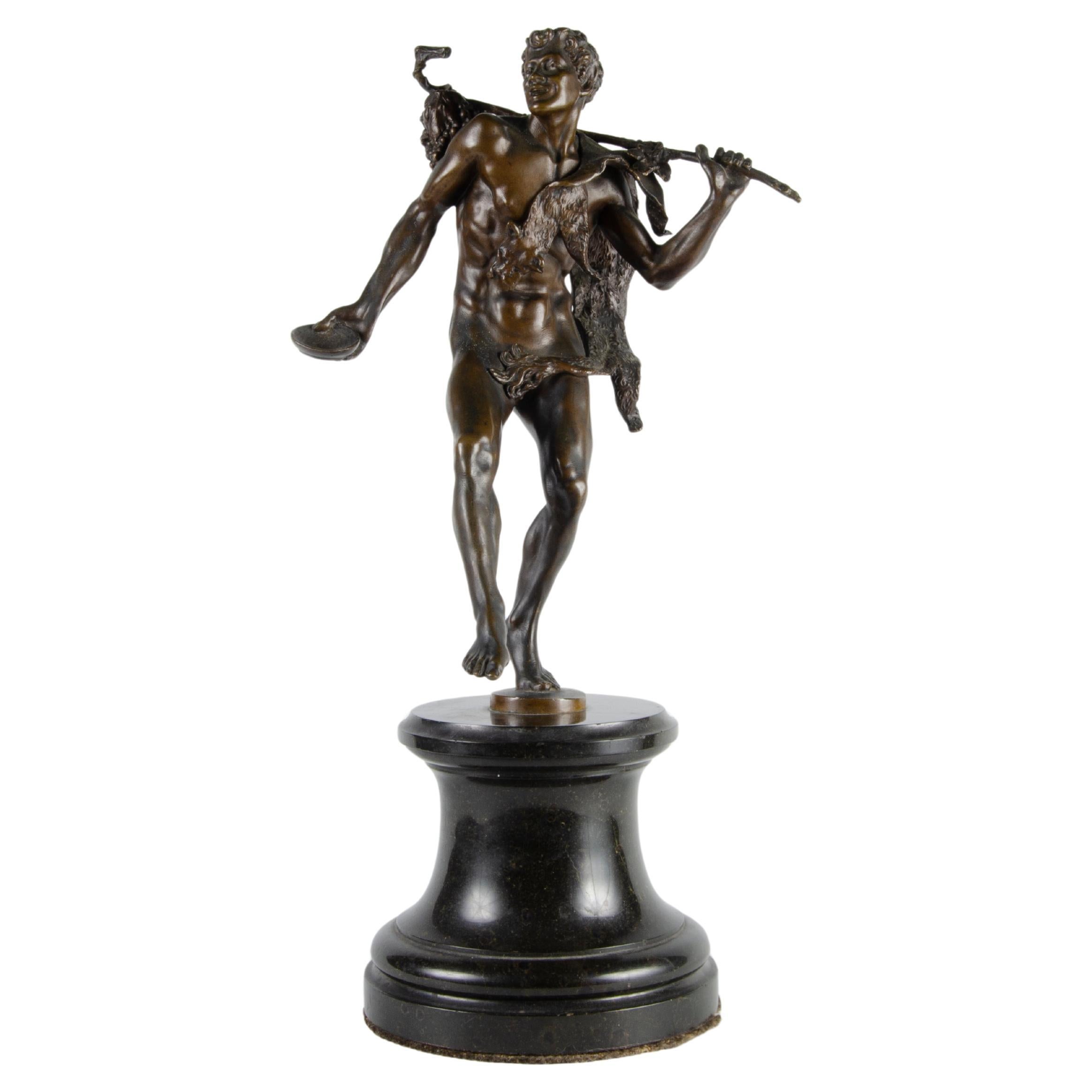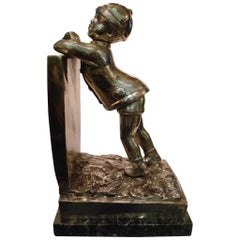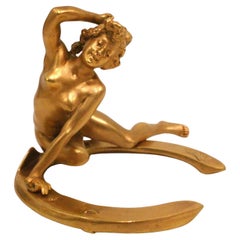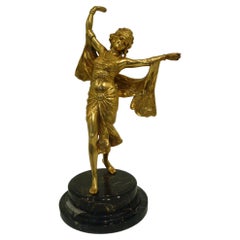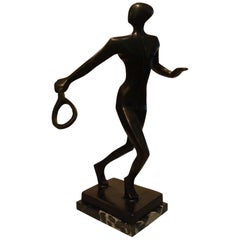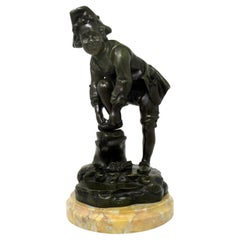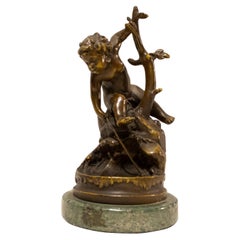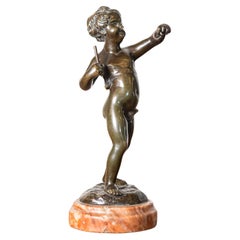Items Similar to Franz Iffland Bronze Sculpture of a Cupid Boy Ice Skater, ca 1900
Want more images or videos?
Request additional images or videos from the seller
1 of 13
Franz Iffland Bronze Sculpture of a Cupid Boy Ice Skater, ca 1900
$1,999
£1,521.40
€1,742.05
CA$2,843.26
A$3,114.85
CHF 1,627.14
MX$37,446.79
NOK 20,342.04
SEK 19,185.78
DKK 13,005.23
About the Item
Bronze depicting a young boy (cupid) ice skating, by Franz Iffland (Berlin 1862-1935). A boy in fur-trimmed cape, holds a cupid-like feathered arrow with bow. Iffland was a member of the Berliner Bildhauerschule, was active 1885-1915. He became most well-known for his sculptures of young children and women. The richly patinated skater stands upon a tall, dark green marble base. Signed F. Iffland; Germany circa 1900.
Franz Iffland, boy / cupid. Well listed artist, Franz Iffland was born in 1862 in Berlin, Germany and died there in 1935. Iffland created bronze portrait busts of young women. He was a painter as well; however, he is primary known for his bronze statues of young children. The majority of his work was produced during the art nouveau period from 1880 to 1910, but late in his career he produced a number of art deco bronzes of nude women and ordinary working people such as blacksmiths and farmers. He presented his work in bronze at the Great Art Exhibition held in Berlin in 1892. A photo of a typical Iffland bronze of a young girl, entitled "Hands on Hips", can be seen on page 595 in Vol. III of Bronze, Sculptors & Founders by Harold Berman.Submitted by Mike Parker, collector of work by the artist.
We have specialized in the sale of Art Deco and Art Nouveau and Vintage styles since 1995. If you have any questions we are at your disposal. Pushing the button that reads 'View All From Seller'. And you can see more objects to the style for sale. Why are there so many antiques in Argentina?
In the 1880 – 1940 there was a grate wave of immigration encouraged by the periods of war that were taking place. 1st World War took place between 1914 and 1918 2nd World War took place between 1939 and 1945 The immigrants options were New York or Buenos Aires. Tickets were cheap and in Buenos Aires they were welcomed with open arms, as it was a country where everything was still to be done. Argentina was the country of new opportunities, labour was needed and religious freedom was assured, in many cases the of the family travel first until they were settled and then the rest of the family members join them. In the immigrant museum “Ellis Island Immigrant Building” in New York you can se the promotional posters of the boats that would take them to a new life. Between the years 1895 and 1896, Argentina had the highest DGP (gross domestic product) per capita in the world according to the Maddison Historical Statistics index, this situation arose due to the large amount of food being exported to European countries, which were at war. The Argentinean ships left the port of Buenos Aires with food, but they returned with furniture, clothes and construction elements, (it´s common to see this the old buildings of the historic neighbourhood of San Telmo, the beams with the inscription “Made in England)”, as well as many markets that were built in Buenos Aires, such us the San Telmo Market, whose structure was brought by ship and afterwards assembled in 900 Defensa Street. With the great influence of European immigrants living in the country, the children of the upper classes travelled to study in France, resulting in the inauguration of “La Maison Argentinienne”, on 27th of June 1928, in the international city of Paris, which hosted many Argentinians that were studying in Frace. It´s the fourth house to be built after France, Canada and Belgium, being the first Spanish-speaking one. Still in place today (17 Bd Jourdan, 75014, Paris, France). Many of the children of these wealthy families who attended international art exhibitions, museums and art courses abroad, took a keen interest in the European style. This is why Buenos Aires was at the time referred as “The Paris of South America”. Between the years 1890 and 1920 more than a hundred Palaces were built on Alvear Avenue the most exclusive avenue in Buenos Aires. Today some of these palaces have been transformed into museums, hotels and embassies. In the year 1936, the Kavanagh building was inaugurated, it was the tallest reinforced concrete building in South America. During 1994 the American Society of Civil Engineers distinguished it as an “international engineering milestone”, and it´s now considered a World Heritage of Modern Architecture. At the time was common to hire foreign architects such as Le Corbusier, who visited Buenos Aires/Argentina in 1929 and in 1948 he drew up the blueprints for a house built in La Plata City (which was declared a World Heritage Site). In 1947, the Hungarian architect Marcelo Breuer designed “Parador Ariston” in the seaside city of Mar del Plata. After an Argentinean student at Harvard University convinced him to come to Argentina. He worked on an urban development project in the Casa Amarilla, area of La Boca. The Ukrainian architect, Vladimiro Acosta, arrives in Argentina in 1928 and worked as an architect until que moved to Brazil. Antonio Bonet, a Spanish architect who worked with Le Corbusier in Paris, arrives in Argentina in 1937, where he carried out several architectural works and in 1938 designs the well-known BFK chair. Andres Kálnay, of Hungarian origin, made around 120 architectural masterpieces, among which the former Munich brewery stands out, he even made the furniture’s design. The German architect, Walter Gropius, director of the Bauhaus, lived in Argentina, where he wrote articles for “Sur” magazine and founded in Buenos Aires, an architectural firm with Franz Möller, who was also an architect, where he built two houses. At the same time several famous designers decided to immigrate to Argentina, among them we can find the well-known French designer, Jean-Michel Frank, who arrived in the country in 1940 and also worked for the Rockefeller family. Special pieces were made, which were sold exclusively in the country, such as the well-known German company “WMF”, who sold their products by catalogue, which were chosen by the ladies of high society in the list of wedding gifts, as well as the pieces designed by Christofle. The Swiss sculptor Alberto Giacometti, made special pieces for Argentinean mansions. In 1904 the first Jansen branch outside Paris was established in Buenos Aires, as the Argentinean clientele demanded a large amount of furniture, from the end of the 19th century to the mid-20th century. In 1970, the brand Rigolleau Argentina made pieces authorised by Lalique. The brands Maple and Thompson also set up shop in the country. The French plastic artist, Marcel Duchamp moved to Argentina in 1918-1919. Glass signed Gallé, Charder, Leverre, Schneider, Muller and other French firms. They were bought in flower shops and were given to ladies with beautiful floral arrangements. Some furniture manufacturers travelled to international fairs and bough the patterns to produce the furniture in Argentina, such as the furniture firm Englander and Bonta, who bought the patterns in Italy. It is worth mentioning that in Argentina we have the largest community of Italians outside of Italy, as it is estimated that 70 percent of the inhabitants have at least one Italian descendant, followed by Spanish immigrants. The most Important furniture stores in Argentina: Comte is founded in 1934 (under the direct management of Jean Michel Frank in 1940). Nordiska (Swedish company established in 1934). Churba in 1960, a company that brought foreign designers to present their furniture in the country: Denmark: (Arne Jacobsen, Finn Juhl, Bender Madsen, Ejner Larsen, Poul Kjaerholm, Hans Wegner) Sweden: (Hans Agne Jakobsson, Gustavsberg) United States: (Herman Miller) Finland: (Lisa Johansson, Folke Arstrom, Tapio Wirkkala, Alvar Aalto, Timo Sarpaneva) Swedish Factory: (Orrefors) Italy: (Littala, Vico Magistretti, Emma Gismondi, Gae Aulenti, Angelo Mangiarotti, Elio Martinelli, Gianna Celada, Angelo Mangiarotti, Mario Bellini, Carlo Scarpa) Finland: (Olivia Toikka) Plata Lappas (Lappas Silver): a goldsmith shop founded in 1887 in Argentina by Alcibiades Lappas of Greek origin. In 2019, in Argentina took place “the Art Deco world congress” . Argentina currently has more than 100 Art Deco buildings and another 90 Art Nouveau buildings throughout the city of Buenos Aires. Argentina is a country that has not been involved in many wars, which is why it has been a refuge for works of art and antiques from different periods of time, unlike European countries. That is way many collectors, museums and antique dealers from all over the world visit it, you should not miss the opportunity to visit this great country.
- Creator:Franz Iffland (Artist)
- Dimensions:Height: 10.63 in (27 cm)Diameter: 4.73 in (12 cm)
- Style:Art Nouveau (Of the Period)
- Materials and Techniques:
- Place of Origin:
- Period:
- Date of Manufacture:1900
- Condition:Wear consistent with age and use.
- Seller Location:Buenos Aires, AR
- Reference Number:1stDibs: LU2027324511152
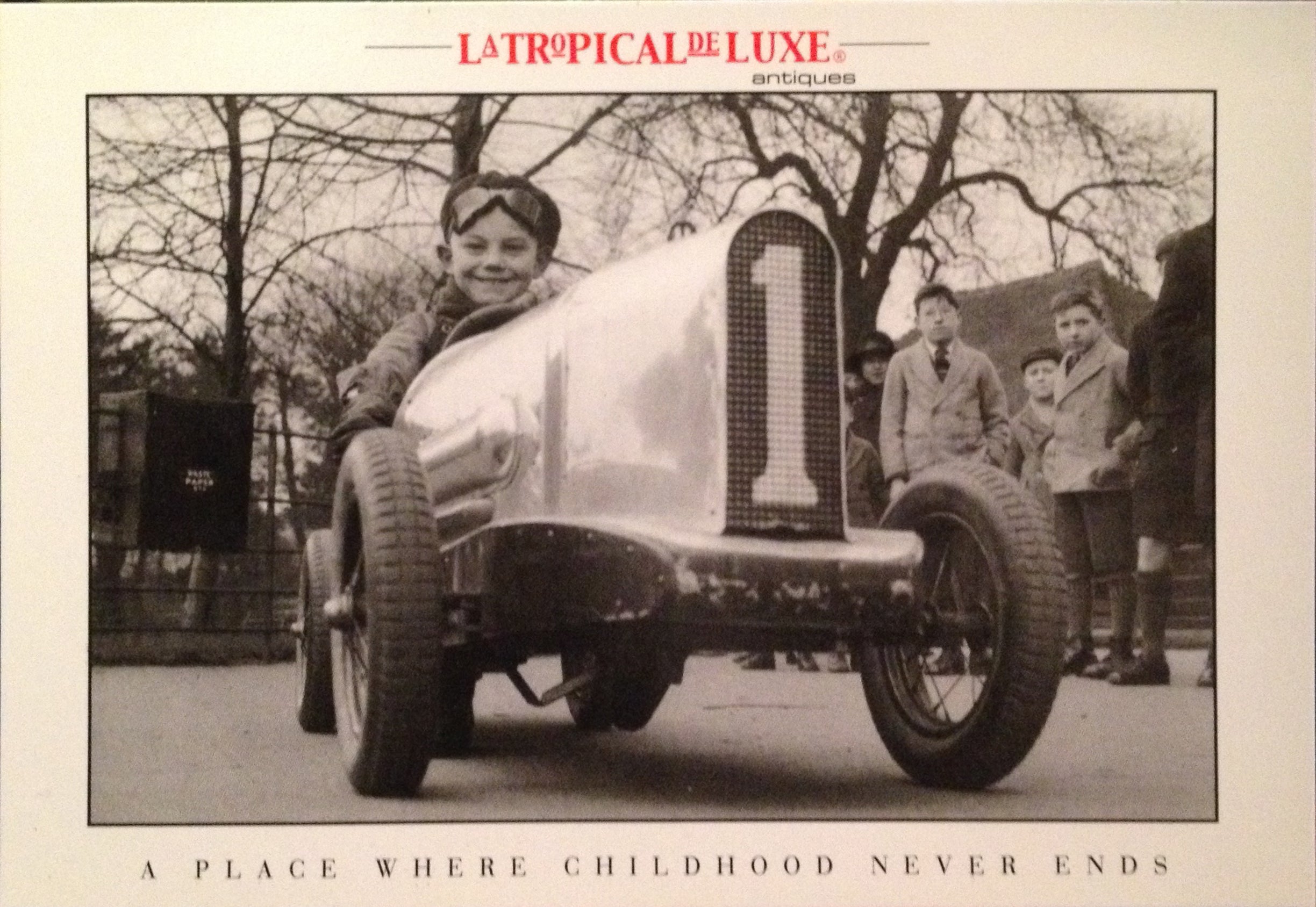
About the Seller
4.9
Vetted Professional Seller
Every seller passes strict standards for authenticity and reliability
Established in 2002
1stDibs seller since 2016
323 sales on 1stDibs
Typical response time: <1 hour
- ShippingRetrieving quote...Shipping from: Buenos Aires, Argentina
- Return Policy
Authenticity Guarantee
In the unlikely event there’s an issue with an item’s authenticity, contact us within 1 year for a full refund. DetailsMoney-Back Guarantee
If your item is not as described, is damaged in transit, or does not arrive, contact us within 7 days for a full refund. Details24-Hour Cancellation
You have a 24-hour grace period in which to reconsider your purchase, with no questions asked.Vetted Professional Sellers
Our world-class sellers must adhere to strict standards for service and quality, maintaining the integrity of our listings.Price-Match Guarantee
If you find that a seller listed the same item for a lower price elsewhere, we’ll match it.Trusted Global Delivery
Our best-in-class carrier network provides specialized shipping options worldwide, including custom delivery.More From This Seller
View AllAlexander Kelety Boy Looking over the Fence Silvered Bronze Sculpture, Art Deco
By Alexandre Kéléty
Located in Buenos Aires, Olivos
Large Art Deco sculpture of boy looking over the fence. Signed A. Kelety. Silvered bronze-mounted over green marble. Russian Boy with Classic snow hat, same c...
Category
Early 20th Century French Art Deco Figurative Sculptures
Materials
Bronze
$2,999 Sale Price
33% Off
Georges Récipon, "Lucky", Gilt Patina Bronze Sculpture / Desk Paperweight
By Georges Récipon, Susse Freres
Located in Buenos Aires, Olivos
Georges Récipon, "Lucky", Gilt Patina Bronze Sculpture / Desk Paperweight. Signed and dated.
Beautiful bronze sculpture (gold patina) representing a naked woman nailed a horseshoe, ...
Category
Antique 1890s French Art Nouveau Figurative Sculptures
Materials
Bronze
Richard Thuss Austrian Gilt Bronze Figure of an Oriental Woman Dancing
Located in Buenos Aires, Olivos
Oriental Dancer, Jugenstil Vienna bronze sculpture, 1900s
Richard Thuss Austrian Gilt Bronze Figure of an Oriental Woman Dancing
Stamped under a foot VNO. Gilt has been restored. It ...
Category
Early 20th Century Austrian Vienna Secession Figurative Sculptures
Materials
Marble, Bronze
20th Century Tennis Player Bronze Sculpture / Trophy, Italy, 1930s
Located in Buenos Aires, Olivos
Midcentury tennis player bronze sculpture / Trophy. Italy, 1930s.
Very nice Italian bronze figure. Mounted over black Portoro marble.
We have speci...
Category
Mid-20th Century Italian Mid-Century Modern Sports Equipment and Memorab...
Materials
Marble, Bronze
Henri Fugere, Bronze Figure, 'Bebe Tapin' Boy Playing His Drum
By Henri Fugère
Located in Buenos Aires, Olivos
Henri Fugere, bronze figure, ' Bebe Tapin ' signed in the bronze.
French Boy playing his drum. Henry Fugere, a well listed artist. Mr. Fugere was born in ...
Category
Early 20th Century French Art Nouveau Figurative Sculptures
Materials
Marble, Metal
Erotic - Nude Woman Viena Bronze Sculpture / Desk Paperweight. Austria 1900´s
By Franz Bergmann
Located in Buenos Aires, Olivos
Erotic - Nude Viena Bronze Sculpture / Paperweight. Austria 1900´s.
Lovely woman nude paperclip or paperweight.
We have specialized in the sale of Art Deco and Art Nouveau and Vinta...
Category
Early 20th Century Austrian Art Nouveau Paperweights
Materials
Bronze
You May Also Like
Antique French Bronze Figure Male Ice Skater Sienna Marble, 19th Century
Located in Dublin, Ireland
Fine quality well cast dark olive green patinated bronze of a young male Skater of generous size, complete with its original well grained Sienna Marble Circular Stepped Base.
Thi...
Category
Antique 19th Century French Regency Figurative Sculptures
Materials
Siena Marble, Bronze
Hand Carved Bronze Sculpture "Playing Boy", France, 20th Century.
Located in Madrid, ES
Sculpture of a boy playing, made of solid hand-carved bronze with a black patina and a circular green marble base. France, 20th century.
Category
20th Century French French Provincial Figurative Sculptures
Materials
Marble, Bronze
19th-Century French Bronze Sculpture of a Cherub by Clodion
Located in Atlanta, GA
This charming 19th-century French bronze sculpture, signed “Clodion”, beautifully captures the playful spirit of a cherub. The figure stands dynamically poised, one arm raised while ...
Category
Antique 19th Century French Figurative Sculptures
Materials
Marble, Bronze
French 19th/20th Century Bronze of a Fairy “Lutin des Bois”, After Luca Madrassi
By Luca Madrassi
Located in Los Angeles, CA
A Fine French 19th/20th Century Patinated Bronze Figure titled “Lutin des Bois” (Woodland Fairy or Elf) after Luca Madrassi (Italian, 1869-1914). The beautifully executed slender fig...
Category
Antique Early 1900s French Belle Époque Figurative Sculptures
Materials
Bronze
$12,450 Sale Price
32% Off
Cupid. Bronze, Marble, After Models from Auguste Moreau ‘1834-1917’
Located in Madrid, ES
On a round base stands the figure of the God of Love, Cupid. The sculpture in bronze, with the iconographic attributes corresponding to this figure in classical mythology, was made b...
Category
20th Century European Neoclassical Figurative Sculptures
Materials
Marble, Bronze
Late 19th Century Bronze Sculpture of a Dancing Satyr/Faun by G. Roth, Germany
Located in North Miami, FL
Late 19th Century Jugendstil bronze sculpture of a dancing Satyr/Faun signed by G. Roth, Germany
By: G. Roth
Material: bronze, copper, tin, metal
Technique: cast, molded, patinated,...
Category
Antique 1880s German Jugendstil Figurative Sculptures
Materials
Stone, Marble, Metal, Bronze, Copper, Tin
More Ways To Browse
Dark Green Marble
Boy Sculpture Marble
Marble Cupid
Bronze Young Girl
Art Deco Nude Bronze Circa 1920
Antique Marble Boy
Cupid With Bow
Antique Green Glass With Gold Trim
Art Nouveau Bronze Germany
Antique Ice Skates
Children Statue
Mid Century Art Nouveau Style Nude Sculpture
Antique French Figurines
Antique Parian
Cold Painted Bronze Bergman
Female Nude Art Deco
French Art Deco Woman
Godhelp De Raad
